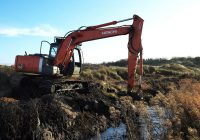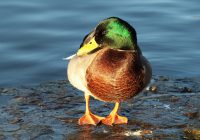Dr Phil Smith’s Wildlife Notes
December 2012
And still the rain came! Another remarkably wet month meant limited time in the field, while rainfall records tumbled. Despite the prolonged spring drought, 2012 was the wettest year in England since recording began. Both the dry and wet periods were attributed to major shifts in the position of the North Atlantic jet stream, this being linked by some experts to warming of the North Atlantic Ocean which began in 1996. The last time this happened was between 1931 and 1960, which also coincided with a run of wet summers.
Comparing present levels in the Sefton dune slacks with photographs taken in early spring after the wet winters of 1976/77, 1980/81, 1994/95 and 1999/2000 suggests we may see record water-depths by the end of this winter, unless, of course, drought conditions return.
With so much rain, the coast road at Birkdale became flooded and I was asked to help supervise the digging out of three overgrown ditches which take water from pipes under the frontal dunes to discharge onto the shore. Because they run through nationally and internationally protected habitats, there was a need to avoid adverse effects on wildlife. With his long experience of conservations projects on the coast, Martin Emery expertly worked his machine around a patch of the rare Tubular Water-dropwort on one drain, removing a clump of Galingale on another for later replanting. In creating soakaways on the Green Beach, we were also able to avoid a population of Variegated Horsetail and create habitat that should benefit Natterjack Toads.
A rare dry day on 8th allowed me to visit Ainsdale beach where a spectacular “wreck” of shellfish, largely Rayed Trough Shells and Sea Potatoes (a type of sea-urchin), had attracted several thousand gulls, mainly Herring, Common and Black-headed. Amongst them, were several Herring Gulls of the darker Scandinavian race and I also spotted a Yellow-legged Gull from south-west Europe. Martin Mere provided poor views of a Woodcock on 9th, while the partially frozen Sands Lake had 175 Tufted Duck and 385 Mallard the following day and another Woodcock on 24th. However, my ornithological highlight of the month was a flock of Waxwings on 16th near Seaforth station. Over 40 were feeding on Sorbus berries at the edge of a carpark. With an appreciative group of watchers, I followed them to nearby derelict land where the flock came down to drink at a rainwater puddle, giving great views.
Having long had an interest in the history of our coast, I recently acquired copies of the Southport Scientific Society’s 1898/99 proceedings from the current President. They include an article on botany by Henry Ball. Lamenting the march of bricks and mortar across the sand-dunes at Birkdale, he wrote:
“To the ordinary onlooker this change is viewed with some satisfaction and he sees the wilderness of sand and swamp giving up its natural weirdness, and becoming the select abode of city merchants, but the naturalist cannot view the change without sincere regret, for in his eyes the ‘wilderness’ is not a wilderness but a veritable paradise, whose particular and diversified inhabitants are his particular friends, who greet him in the early spring from their sheltered nooks, who linger around his feet in late autumn, who are the boon companions of his summer walks, and who afford him food for reflection and enjoyment during winter days; and well he knows that one inevitable result of the handiwork of the speculating builder will be the destruction or migration of many of his dear friends”.
Remarkably, over a century later much of this “veritable paradise” still survives. Indeed, we are still finding plants to add to the already impressive inventory for the sand-dune coast. My 2012 update includes no less than 20 new records. Admittedly many of these are garden-escapes but four are native plants not previously listed. These additions bring the total number of vascular plants identified on the Sefton Coast to 1327, of which 1197 were recorded in the dune system. This seems to be about twice as many as on any other coastal dune area in Britain.




